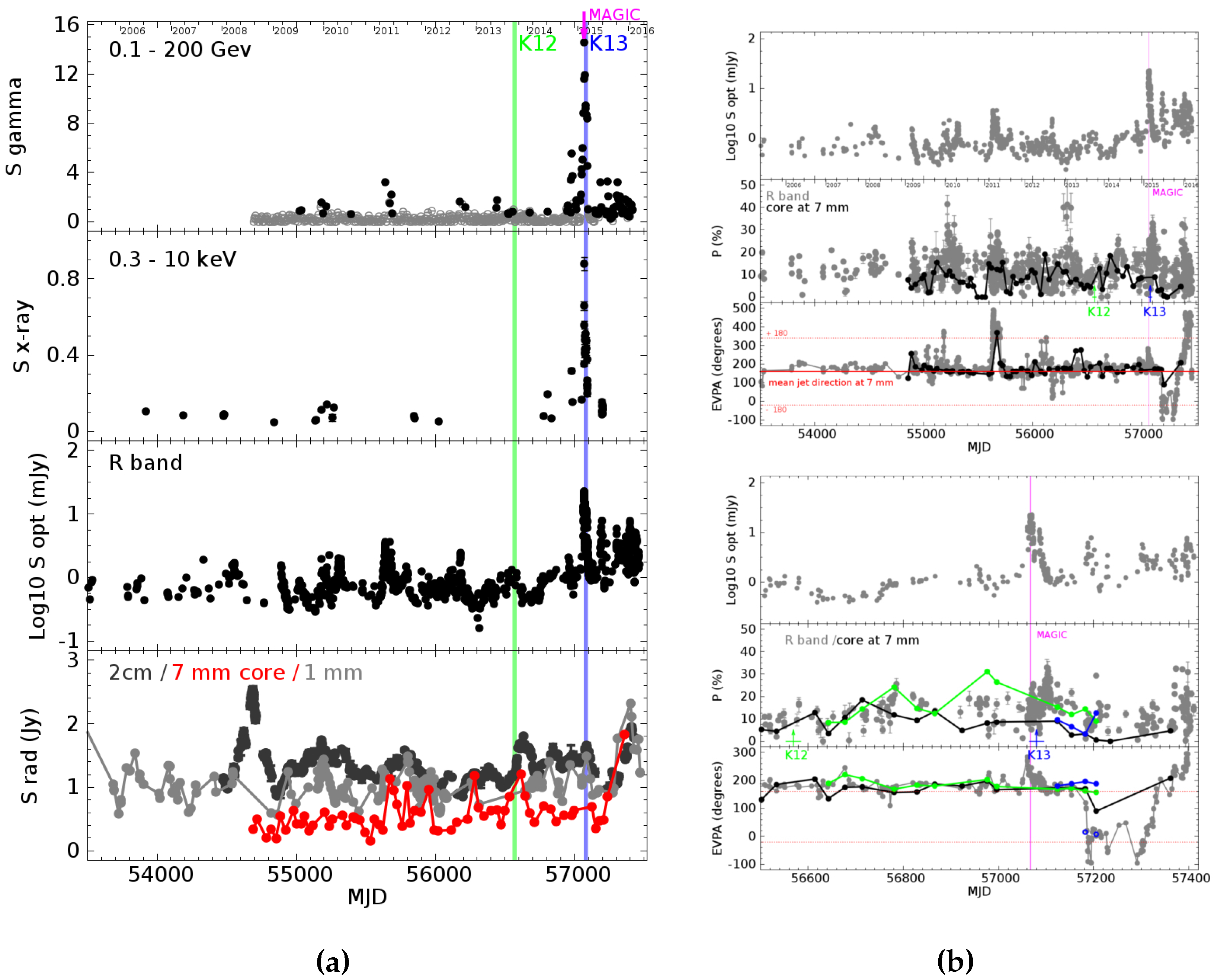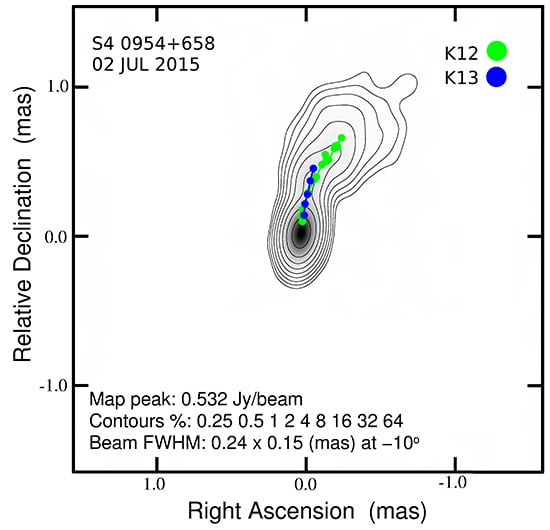Optical Outburst of the Blazar S4 0954+658 in Early 2015
Abstract
:1. Introduction
2. Observation and Data Reduction
3. Results and Discussion
Acknowledgments
Author Contributions
Conflicts of Interest
References
- Raiteri, C.M.; Villata, M.; Tosti, G.; Fiorucci, M.; Ghisellini, G.; Takalo, L.O.; Sillanpää, A.; Valtaoja, E.; Teräsranta, H.; Tornikoski, M.; et al. Optical and radio behaviour of the blazar S4 0954+65. Astron. Astrophys. 1999, 352, 19–31. [Google Scholar]
- Hagen-Thorn, V.A.; Larionov, V.M.; Arkharov, A.A.; Hagen-Thorn, E.I.; Blinov, D.A.; Morozova, D.A.; Troitskaya, Y.V.; Takalo, L.O.; Sillanpyää, A. Optical variability of the blazar S4 0954+658 in 2008–2012. Astron. Rep. 2015, 59, 551–562. [Google Scholar] [CrossRef]
- Morozova, D.A.; Larionov, V.M.; Troitsky, I.S.; Jorstad, S.G.; Marscher, A.P.; Gómez, J.L.; Blinov, D.A.; Efimova, N.V.; Hagen-Thorn, V.A.; Hagen-Thorn, E.I.; et al. The Outburst of the Blazar S4 0954+658 in 2011 March–April. Astron. J. 2014, 148, 42. [Google Scholar] [CrossRef]
- Larionov, V.M.; Jorstad, S.G.; Marscher, A.P.; Raiteri, C.M.; Villata, M.; Agudo, I.; Aller, M.F.; Arkharov, A.A.; Asfandiyarov, I.M.; Bach, U.; et al. Results of WEBT, VLBA and RXTE monitoring of 3C 279 during 2006–2007. Astron. Astrophys. 2008, 492, 389–400. [Google Scholar] [CrossRef]
- Atwood, W.B.; Abdo, A.A.; Ackermann, M.; Althouse, W.; Anderson, B.; Axelsson, M.; Baldini, L.; Ballet, J.; Band, D.L.; Barbiellini, G.; et al. The Large Area Telescope on the Fermi Gamma-Ray Space Telescope Mission. Astrophys. J. 2009, 697, 1071–1102. [Google Scholar] [CrossRef]
- Stroh, M.C.; Falcone, A.D. Swift X-Ray Telescope Monitoring of Fermi-LAT Gamma-Ray Sources of Interest. Astrophys. J. Suppl. Ser. 2013, 207, 28. [Google Scholar] [CrossRef]
- Jorstad, S.G.; Marscher, A.P.; Lister, M.L.; Stirling, A.M.; Cawthorne, T.V.; Gear, W.K.; Gómez, J.L.; Stevens, J.A.; Smith, P.S.; Forster, J.R.; et al. Polarimetric Observations of 15 Active Galactic Nuclei at High Frequencies: Jet Kinematics from Bimonthly Monitoring with the Very Long Baseline Array. Astron. J. 2005, 130, 1418–1465. [Google Scholar] [CrossRef]
- Richards, J.L.; Max-Moerbeck, W.; Pavlidou, V.; King, O.G.; Pearson, T.J.; Readhead, A.C.S.; Reeves, R.; Shepherd, M.C.; Stevenson, M.A.; Weintraub, L.C.; et al. Blazars in the Fermi Era: The OVRO 40 m Telescope Monitoring Program. Astrophys. J. Suppl. Ser. 2011, 194, 29. [Google Scholar] [CrossRef]
- Gurwell, M.A.; Peck, A.B.; Hostler, S.R.; Darrah, M.R.; Katz, C.A. Monitoring phase calibrators at submillimeter wavelengths. In Z-Machines to ALMA: (Sub)Millimeter Spectroscopy of Galaxies; NASA: Greenbelt, MD, USA, 2007; Volume 375, p. 234. [Google Scholar]
- Mirzoyan, R. Discovery of Very High Energy Gamma-Ray Emission from the FSRQ S4 0954+65 with the MAGIC telescopes. The Astronomer’s Telegram ATel7080. Available online: http://www.astronomerstelegram.org/?read=7080 (accessed on 20 August 2016).
- Tanaka, Y.T.; Gonzalez, J.B.; Itoh, R.; Finke, J.D.; Inoue, Y.; Ojha, R.; Carpenter, B.; Lindfors, E.; Krauss, F.; Desiante, R.; et al. A significant hardening and rising shape detected in the MeV/GeV νFν spectrum from the recently discovered very-high-energy blazar S4 0954+65 during the bright optical flare in 2015 February. Publ. Astron. Soc. Jpn. 2016. [Google Scholar] [CrossRef]
- Agudo, I.; Gomez, J.L.; Marti, J.M.; Ibanez, J.M.; Marscher, A.P.; Alberdi, A.; Aloy, M.A.; Hardee, P.E. Jet Stability and the Generation of Superluminal and Stationary Components. Astrophys. J. 2001, 549, L183–L186. [Google Scholar] [CrossRef]



© 2016 by the authors; licensee MDPI, Basel, Switzerland. This article is an open access article distributed under the terms and conditions of the Creative Commons Attribution (CC-BY) license (http://creativecommons.org/licenses/by/4.0/).
Share and Cite
Morozova, D.; Larionov, V.; Jorstad, S.; Marscher, A.; Troitskaya, Y.; Troitskiy, I.; Blinov, D.; Borman, G.; Gurwell, M. Optical Outburst of the Blazar S4 0954+658 in Early 2015. Galaxies 2016, 4, 24. https://doi.org/10.3390/galaxies4030024
Morozova D, Larionov V, Jorstad S, Marscher A, Troitskaya Y, Troitskiy I, Blinov D, Borman G, Gurwell M. Optical Outburst of the Blazar S4 0954+658 in Early 2015. Galaxies. 2016; 4(3):24. https://doi.org/10.3390/galaxies4030024
Chicago/Turabian StyleMorozova, Daria, Valeri Larionov, Svetlana Jorstad, Alan Marscher, Yulia Troitskaya, Ivan Troitskiy, Dmitriy Blinov, Georg Borman, and Mark Gurwell. 2016. "Optical Outburst of the Blazar S4 0954+658 in Early 2015" Galaxies 4, no. 3: 24. https://doi.org/10.3390/galaxies4030024






